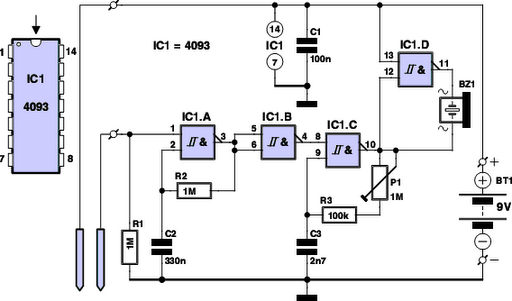Home » Circuits
Water Alarm Circuit Diagram
Have you ever seen the stairs to one of the upper stories in your house turn into a waterfall? Or maybe you’ve come home to find your aquarium fish trying to swim across the carpet? For your sake, we hope not, because the consequences are usually fairly dramatic. With a handful of electronic components, you can at least ensure that you will be warned before you have to put on your waders. It’s better to prevent water problems than to have to correct them. But no how many precautions you take, an occasional leak can still happen.A burst water supply hose for the washing machine, a bath tap that someone forgot to turn off, a broken aquarium wall, or a leaking boiler or central heating tank – anything is possible. In such cases, it’s nice to be warned as quickly as possible, for example by an acoustic water alarm. Then you can at least limit the damage. If you’re handy with a soldering iron and know the difference between an IC and a PC, you’ll no doubt enjoy building the electronic water alarm described here.
The circuit takes advantage of the fact that ‘normal’ water is always slightly contaminated, even if only slightly, and thus conducts electricity to a certain extent. It is built around an popular IC from the somewhat antiquated 4000-series logic family: the 4093. This IC contains four inverted-output AND gates (NAND gates) with Schmitt-trigger inputs. If water is detected between the probes, it emits an intermittent and rather irritating beeping tone.
Circuit diagram:
The conductivity of the water is used to active the circuit built around IC1a. The two electrodes (probes) are fitted at the lowest point where water will come to stand. They can be two tinned copper wires, but you can also use two pieces of circuit board with the copper surface coated with solder. The combination of IC1a, resistor R2 and capacitor C2 forms a simple oscillator that produces the intermittent (on/off) effect of the alarm. If no water is present between the probes, the input of IC1a is held low by R1 and the output of IC1b is also low.
The oscillator is not active in this state. If moisture is sensed, the supply voltage pulls input 1 of gate IC1a high via the conductive water, causing the gate to start oscillating. Whenever the output of IC1b is high, the tone generator built around IC1c is enabled, and in turn it energizes buzzer BZ1. The net result is a periodic, intermittent beeping tone. You can adjust the intermittent effect of the sound produced by the water alarm to suit your taste by simply adjusting the value of R2 or C2. You can also set the pitch of the sound with P1.
The closer the pitch is to the resonant frequency of buzzer BZ1, the louder the tone will be. You should set the sound to the most irritating level possible. Gate IC1d is used to boost the amount of power than can be pumped into the buzzer. It inverts the output signal from IC1c to double the voltage applied to the buzzer. Naturally, the circuit of the alarm must be fitted somewhere that will remain high and dry. Use a pair of thin twisted wires to connect the electrodes (probes) to the board. Naturally, you should use insulated, flexible wire for this purpose.
Twisting the wires together makes the relatively long connection between the probes and the circuit less sensitive to false alarms due to external electromagnetic interference. The current consumption is very low (less than 0.1µA) when everything is dry. When the buzzer is energized, the current consumption can rise to around 2mA. We measured 3mA with the frequency set to the maximum value. The battery will thus last for several years as long as no water is detected. Of course, you should bear in mind that the battery might start leaking after a while…
Source: Elektor Electronics 12-2010

